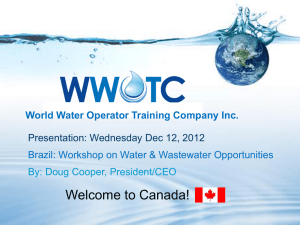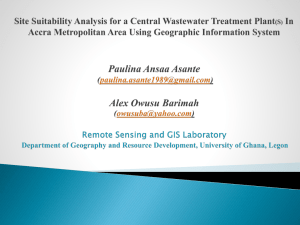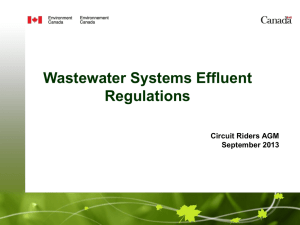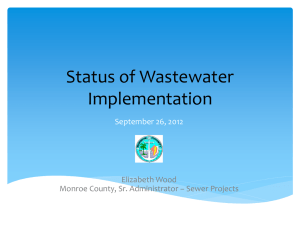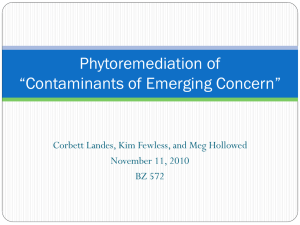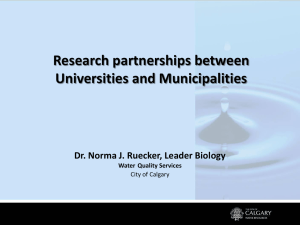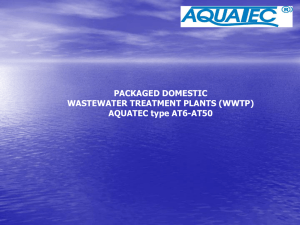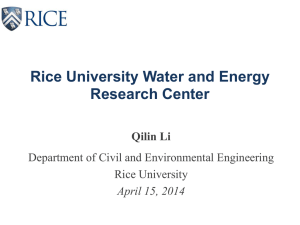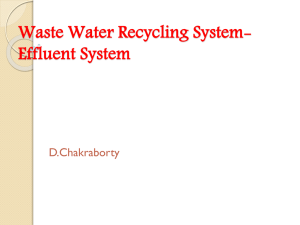wastewater system effluent regulations
advertisement
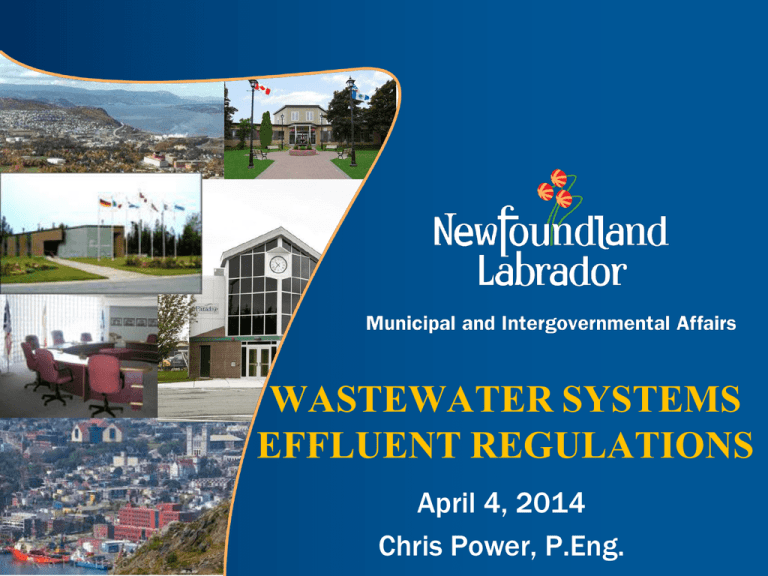
WASTEWATER SYSTEMS
EFFLUENT REGULATIONS
April 4, 2014
Chris Power, P.Eng.
Wastewater
Definitions
Wastewater is composed of industrial,
commercial, institutional and domestic
wastes including blackwater &
greywater.
Effluent: wastewater that is deposited
from a wastewater system
Influent: means wastewater entering a
wastewater system
What is WSER?
Wastewater Systems Effluent Regulations
• Established (July 18, 2012) under the (Federal)
Fisheries Act to regulate wastewater outflows
• Sets minimum effluent quality standards achieved
through secondary wastewater treatment
• Defines sampling, monitoring, record keeping &
reporting requirements
• Will help protect rivers, lakes and oceans with a
workable set of rules for Canada's approximately
4000 wastewater treatment systems.
Application
• Applicable to wastewater systems that collect, or
are designed to collect, an average volume of 100
mᶟ/d or more of influent.
• Not Applicable to • Wastewater systems located in the far north
(Nunavut, the Northwest Territories), north of
54th parallel in Newfoundland & Labrador &
Quebec
• Systems on the site of industrial, commercial or
institutional facilities that are designed to collect
less than 50% of blackwater and greywater
combined.
• Mills as defined in the Pulp and Paper Effluent
Regulations
Geographic exception in NL
Wastewater in NL
• Approx. 739 sewer outfalls in the
province of Newfoundland & Labrador
• WSER applies to the outfall not the
community
WSER
• WSER does not cover very small
discharges
• Existing provincial policy of no new
raw water discharges will apply.
100 mᶟ/d of influent equates to
• 100,000 Litres/day
• Approximately 294 people or 147 homes (E.g.
assuming 340 litres/person/day and 2
people/home)
Determine if the outfall is 100 m3
• Communities should do a desktop assessment
on all individual outfalls to determine eligibility
if the outfall is 100 m3 or not (and keep
documented results!!)
• Communities can use their data on how many
people connected to the system
• If a community’s outfall is clearly over 100 m 3
then Start flow monitoring
Flow Monitoring
• Consider consultant to assist in flow
monitoring
• Smaller communities in the same
geographical region may work
together and hire a consultant for flow
monitoring. This will be the most
economical approach.
Effluent Quality Standards
• Wastewater discharges must meet
Carbonaceous
Total
Un-ionized
biochemical
Total residual
Suspended
ammonia
oxygen Demand
Chlorine (TRC)
Solids (TSS)
(NH3)
(CBOD)
Average
Average
Average
Maximum
≤ 25 mg/L
≤ 25 mg/L
≤ 0.02 mg/L
˂ 1.25 mg/L
Types of Wastewater Systems
Two types (for the purpose of regulation)
1. Intermittent Wastewater system:
Hydraulic Retention Time (HRT) of at least 90
days, four discharge periods per year
2. Continuous Wastewater System: Any
wastewater system other than an intermittent
wastewater system
Newfoundland & Labrador has continuous systems for
the most part according to Environment Canada
Intermittent System SamplingCBOD, SS and NH3
Duration of
Deposit
Type of Sample
to be Taken
Minimum Sampling
Frequency
>30 days
Grab or
composite
Every 2 weeks but
at least 7 days
after any other
sample
≤ 30 days
Grab or
composite
Once per discharge
period
Continuous Systems SamplingCBOD, SS and NH3
Annual Average Daily
Volume (m3)
Type of Sample
Minimum Sampling
Frequency
≤ 2500
Grab or composite
Monthly, but at least
10 days after any
other sample
> 2500 and ≤ 17500
Composite
Every 2 weeks, but at
least 7 days after any
other sample
> 17500 and ≤ 50000
Composite
Weekly, but at least 5
days after any other
sample
> 50000
Composite
3 days a week, but at
least 1day after any
other sample
Continuous Systems with HRT ≥ days SamplingCBOD, SS and NH3
Annual Average Daily
Volume (m3)
Type of Sample to be
Taken
Minimum Sampling
Frequency
≤ 2500
Grab or composite
Quarterly, but at least
60 days after any
other sample
> 2500 and ≤ 17500
Grab or composite
Every 2 weeks, but at
least 7 days after any
other sample
> 17500 and ≤ 50000
Grab or composite
Weekly, but at least 5
days after any other
sample
> 50000
Grab or composite
3 days per week, but
at least 10 days after
any other sample
Acute Lethality Testing
Annual Average
Daily Volume
(m3)
Type of Sample
To be Taken
Minimum
Sampling
Frequency
Reduced Sampling
Frequency
> 2500 and
≤ 50000
Grab
Quarterly, but at
least 60 days
after any other
sample
Annually, but at
least 6 months
after any other
sample
> 50000
Grab
Monthly, but but
at least 21 days
after any other
sample
Quarterly but at
least 60 days after
any other sample
Sampling
• There is currently no lab in the province
accredited to test effluent for CBOD, SS
and NH3. The nearest accredited lab is in
Bedford, NS.
• AGAT Labs -Mt. Pearl (709-896-0888)
(samples collection depot)
Labs previously used by DOEC
a. Maxxam Analytics Inc.
b. Exova Canada Inc.
• Maxxam St. John’s office can coordinate with Bedford
office to send samples for testing. Contact Maxxam at:
(709) 754-0203 or (902) 832-4852
Sampling
• EC suggests that towns should request that the
following be tested for:
•Carbonaceous BOD (CBOD)
•pH
•Total Suspended Solids (TSS)
•Unionized Ammonia @ 15oC (as NH3)
Flow Meters and Monitoring
• Flow monitoring equipment to be installed as soon
as possible by owners and operators of wastewater
systems (if required). Maintenance and calibration
of equipment is required.
• All outfalls (subject to WSER) need be monitored. A
representative sample may be chosen and results
applied to remaining outfalls.
• For information on available flow meters, visit the
following websites:
• http://www.3spgroup.com/3SPG/Applications_homeES.php?locale=en&A
pplication_no=7
• http://www.wastewatercanada.com/index.htm
• http://www.environmental-expert.com/waterwastewater/sewers/products/keyword-sewer-flow-monitoring14731/location-canada-newfoundland
• http://biomaxx.ca/products.php
Implementation Timelines
• Wastewater systems not meeting the effluent
quality standards would need to upgrade their
systems to meet the standards
• Data collected through the quantity and quality
monitoring program is converted into a score
• Score is then used to determine the level of
environmental risk associated with the outfall and
the timeframe required to meet the new effluent
requirements.
• 2020 (high risk), 2030 (medium risk) or 2040 (low
risk) timeline
Implementation Timelines
January 1, 2013
• Effluent quality and quantity
monitoring begins.
• Combined sewer overflow (CSO)
recording begins.
• Record keeping and reporting
requirements are in force.
• Records must be kept for 5 years
Implementation Timelines
May 15, 2013
• Deadline to submit identification
report for wastewater systems in
operation on January 1, 2013.
This is a one time requirement
• Deadline to submit first quarterly
monitoring report (If applicable)
Submit ID Reports online
• Access Effluent Regulatory Reporting
Information System (ERRIS) via
Environment Canada’s Single
Window Information Manager (SWIM)
EC is ready to assist municipalities to
navigate SWIM & ERRIS
• Create an account with SWIM
• After log-in, user is linked to SWIM
• Within SWIM, create your user profile
• Then go ERRIS
EC Single Window Information System (SWIM)
SWIM web link
https://ec.ss.ec.gc.ca/en/cs?&GAURI=
https://ec.ss.ec.gc.ca/auth/{l2},https://
ec.ss.ec.gc.ca/auth/en&GAREASONCO
DE=-1&GARESOURCEID=ecssecgccap1
ap1&Reason=-1&APPID=ecssecgccap1
&URI=https://ec.ss.ec.gc.ca/auth/en
ERSIS
Implementation Timelines
February 14, 2014
• Deadline to submit first annual
monitoring report (If applicable).
February 15, 2014
• Deadline to submit first CSO
report.
Implementation Timelines
June 30, 2014
• Deadline to apply for transitional
authorization (TA).
• TA requires a year’s worth of flow and
quality data.
• WW systems not meeting standards
can apply
• Conditions will be set under which the
facility may continue to operate, as well
as risk based timeline for achieving
final compliance
Implementation Timelines
January 1, 2015
• Effluent quality standards and limits in
TAs are in force.
• Exception: TRC standard for <5000
m3/day wastewater systems – Jan
1, 2021.
• Application for temporary bypass
authorizations may be submitted
• Acute lethality monitoring begins for
wastewater systems that already meet
the effluent quality standards.
Implementation Timelines
June 30, 2017
• Deadline to submit the progress
report for wastewater systems
with a TA expiry date of December
31, 2020.
Timeline Summary
July 2012
WSER
became law
Jan 1, 2013
-Effluent flow and quality monitoring
must start
-Record keeping starts (must keep for 5 yrs.)
-Reporting starts
(45 days after end of quarter)
-Applications for Trans. Authorizations
and Temp. Authorizations can be made
(including required plans)
Jan 1, 2015
The following come into effect:
-NPS
-Authorizations to Deposit
-Trans. Authorizations
-Temp. Authorization (for NH3 - Jan 1, 2014)
-Temp. Bypass Authorization
-Acute toxicity testing starts
-Notification of deposit of a deleterious
substance
Dec 31, 2020
Compliance for High Risk
May 15, 2013
Outfall ID Report due
Plans
-Consolidation Plan
-Wastewater System
Modification Plan
-Wastewater System
(Overflow) Modification Plan
Reports
-Identification Report (once)
-Monitoring Report (annual-quarterly)
-Overflow Report (annual)
-Progress Report (every 5 yrs.)
June 30, 2014
-Application for Transitional
Authorization due
-Requires a years worth of flow
and quality data
Dec 31, 2030
Compliance for Medium Risk
Progress Reports
-July 1, 2017
-July 1, 2020
-July 1, 2025
-July 1, 2030
-July 1, 2035
Dec 31, 2040
Compliance for Low Risk
Funding
• Funding for Flow Meters is eligible under MCW and
MYCW program of MIGA. However this year’s
applications are now closed. Gas Tax may be used
with approval of GT Secretariat.
• Monitoring Costs are not eligible.
• Wastewater treatment infrastructure is an eligible
category under the Provincial-Territorial Base
Fund, the Green Infrastructure Fund and Gas Tax
Fund. The Federal budget made a commitment to
the renewal of a 10-year Building Canada
Infrastructure Program which the province
anticipates will cover WWT.
Flow Meters
Following are a few examples of Flow meters suppliers
It is important to ensure and check purchases against
obligations of the Public Tender Act.
1. Avensystems Solutions
Dartmouth, NS B2X 1S1
Tel: 902-469-4400
www.AvensysSolutions.com
2. Can-Am Instruments Ltd.
Tel: 1-800-215-4469
www.can-am.net
3. BioMaxx
Tel: 1-855-940-5556
www.biomaxx.ca
Contact Information
• Environment Canada is the primary interface for
administration of regulations in the province.
• General wastewater contact:
• email ww-eu@ec.gc.ca or
• EC Wastewater toll free line 1-800-668-6767
• DOEC (NL) are not administering the regulations
• Community reports from their outfall database can be provided
by contacting DOEC.
• WSER is available online at:
• http://laws-lois.justice.gc.ca/PDF/SOR-2012-139.pdf
• For more information and online reporting system, visit:
• www.ec.gc.ca/eu-ww
WSER
Thank you
Any Questions?
chrispower@gov.nl.ca



